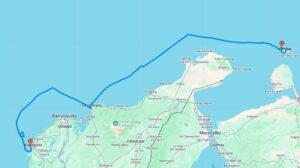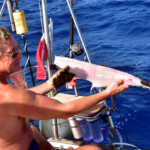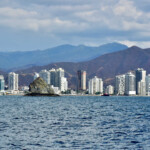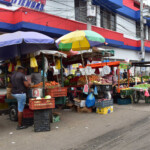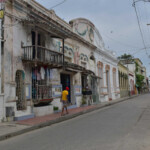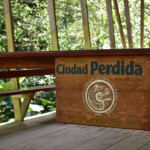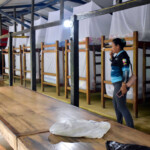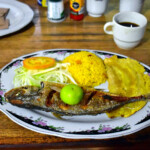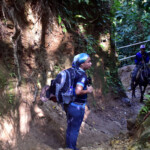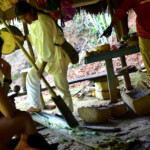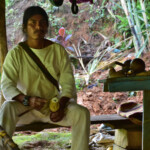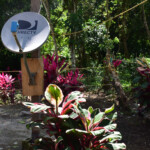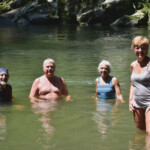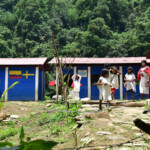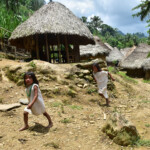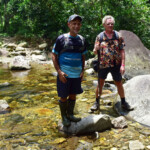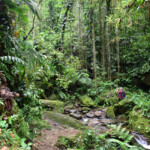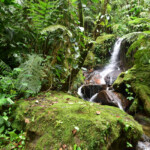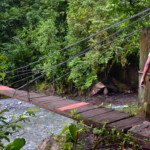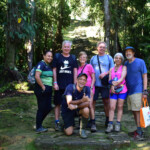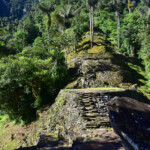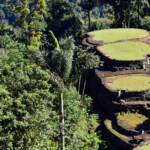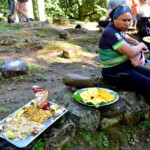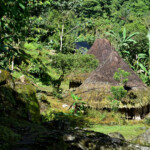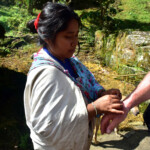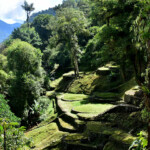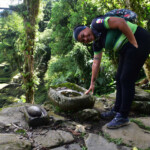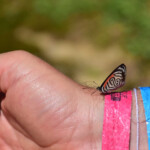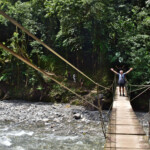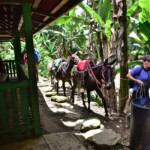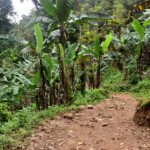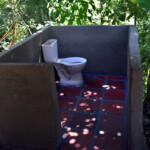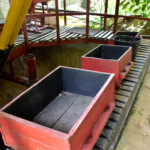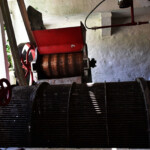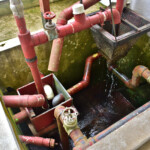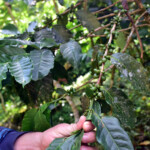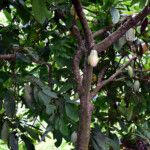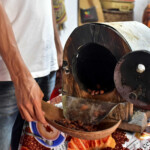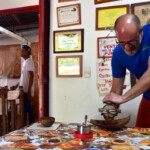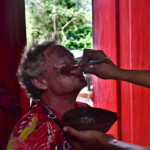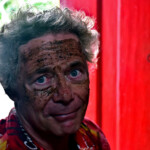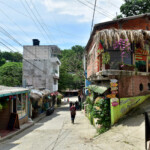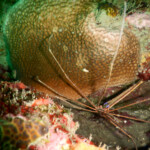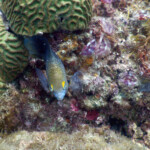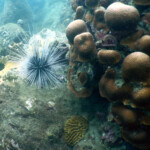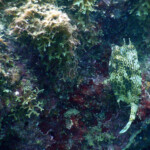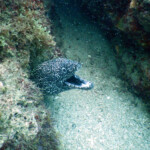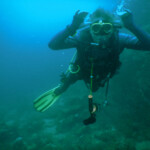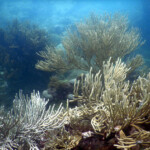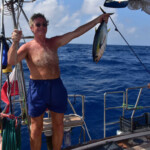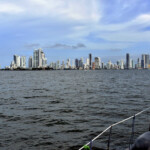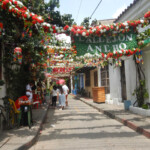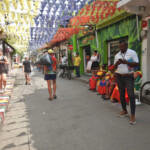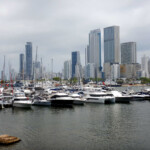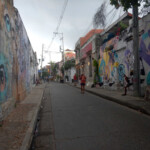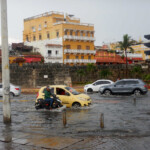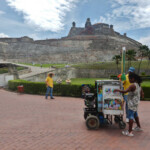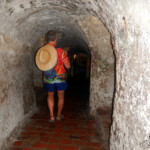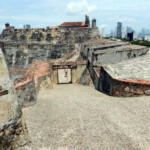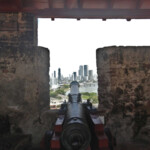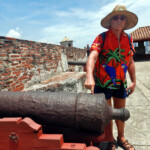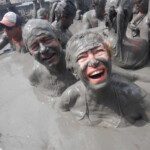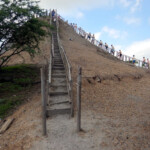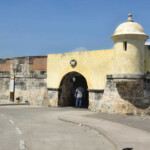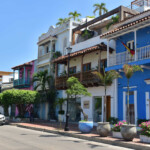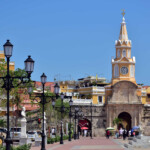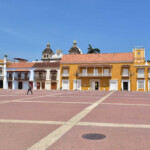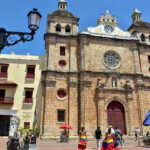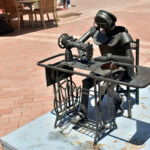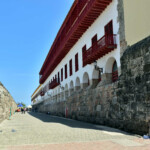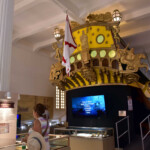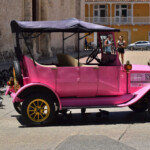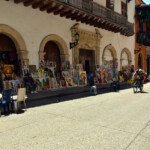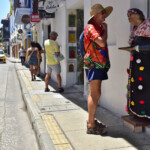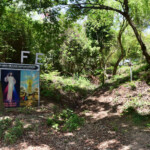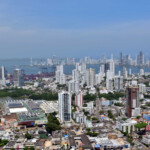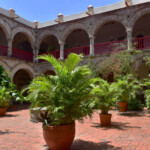Date: 02-19.05.2025
Route: Oranjestad-Barcadero-Santa Marta-Cartagena
Miles/hours: 497Nm/108h
Aruba
Check-out
You have to sail the yacht to Barcadero.
Check-out is simple, at Immigration the lady adds an exit stamp to the entry list of crew and copies it 2 times (one for me and one for Customs) – this is provided that nothing changes in the crew composition in relation to the crew that sailed to Aruba.
At customs I give the SailClear number, they print, stamp and that’s all.
Way to Santa Marta
We leave Barcadero around 10:30. The weather is beautiful, we sail on a genoa of almost 8kn (including 2kn of current in the some direction). We let out the rod and a small fish catches up relatively quickly, unfortunately when we try to pull it out it breaks off. We don’t give up and try to continue fishing. We catch sargassum several times, until we finally catch over 7 kg of Wahoo. It is 120 cm long. The blood of the fish is everywhere on the stern, but fortunately it comes off easily. Tomek dresses the fish, and Marcin portions it and we pack it into the freezer.
We add a jib on the other side. In the evening, a large school of dolphins visits us and swims with us for almost an hour. We take photos and make videos. It is beautiful.
We leave the jib alone for the night, and still the average speed per day is 6kn. Daily distance is 160Mm.
Colombia
Check-in
We can enter the marina on a weekday. We arrived on Sunday, so we spent the night at anchor in front of the marina. The next day after entering the marina, we waited at the petrol station until the dockmaster showed us our place. After mooring, I filled in the entry form, handed in my passports, the zarp from the previous port and the boat registration certificate – they told us to wait at Immigration. They said we would be waiting for about 1 hour, maybe 2 or max 3. We waited over 5 hours.
Finally, I got a message that I could come to the office. Our passports and other documents were waiting in the office. The lady had the entry form on her computer and said that we had to report 2 days before leaving and provide details of our further journey.
Marina Santa Marta
A nice marina close to the city. We moor in quite short Y-booms, although the marinero specially transfers an additional cleat from the neighbouring jetty for us. The exit from the jetties is through gates opened with a fingerprint (all crew members must be registered). The toilets and the exit gate from the marina are opened with a face image. The guys go through without any problems, and I have to stand on my toes. The toilets are clean and even the men’s room has air conditioning.
Currency exchange and payments
We exchange currency at the exchange office 1EUR = 4300COP, 1USD = 3850COP. We are millionaires!!!
In some places adding 3% to card payments, even in stores.
Trip to the Lost City (Ciudad Perdida)
All agencies that organize trekking to the Lost City have the same price of 1860 COP, or about 450USD (plus 3% for card payments) for a 4-day trek. If we choose an intermediary, there will be an additional agency commission. As part of this fee, we get full board (3 meals, and 2 meals on the first and last day), accommodation in beds with bedding and mosquito nets, a guide, translator, cook, entry to the park and reserve, transport to the starting point and back, insurance and a fee for the local population. We choose the Turcol office near the marina (the first office that started organizing treks to the lost city). There are 5 of us tourists in total (a couple from the USA is also going with us), a guide – Paola, translator Marcelo and a cook.
Day 1: The adventure begins – Cabaña Adán
Our adventure began in Santa Marta. Before setting off, Tomek has a small adventure – the soles of his hiking boots fall off – he returns to the yacht and takes other shoes, and throws the soles away. On the way, we stop in Aguacatera where we get bracelets, which are tickets to the park. After reaching the village of Mamey, we had lunch and started trekking through the lush jungle of Sierra Nevada de Santa Marta. We had to walk about 8 km – most of it uphill but a bit downhill. We reached the camp at about 16:30. It was raining on the way, so most of our clothes were wet. We spent our first night at the Cabaña Adán camp, where we found simple but comfortable conditions – spacious bunk beds with mosquito nets, blankets and pillows (there were few people in the camp, so everyone could sleep on the lower beds), a communal kitchen and the opportunity to immerse ourselves in the local atmosphere. In the evening, we ate meals prepared by the local community, which were tasty and filling.
Day 2: Hike to Cabaña Paraíso
We started the second day early in the morning (wake up at 5:00), covering more kilometres deep into the jungle. Along the way, we passed numerous streams and rivers that we had to cross, which added an adventurous nature to the expedition. On the way, the sole of my right shoe fell off, but the left one was still good, so I managed to keep going. We spent the night in the Cabaña Paraíso camp, where we had the opportunity to rest and prepare for the upcoming challenges. We also met representatives the indigenous communities of Kogui and Wiwa, who are the spiritual guardians of these lands.
Day 3: Climbing Ciudad Perdida
The third day was the culmination of our expedition. After breakfast in the morning, we began the climb to Ciudad Perdida, overcoming over 1,200 stone steps rising to the ancient city. The views were breathtaking – surrounded by lush vegetation, we reached the top, where terraces and a central square awaited us. Guide Paola told us the history of this place, which was founded around 800 AD, making it about 650 years older than Machu Picchu. On the way back, the second sole fell off on the stairs, now my hiking boots resembled slippers and like slippers they did not grip the ground at all. The matter was improved somewhat by 2 poles and the help of Marcel. After exploring Ciudad Perdida, we began our descent, stopping at the Cabaña Mumake camp, where we spent the night.
Day 4: Return via Cabaña Umake and Población del Mamey
The next day we reached Población del Mamey, where delicious meals awaited us. The trek was demanding but rewarding – the high humidity, mud and numerous elevations made us feel like true explorers.
Encounters with indigenous communities
Throughout the expedition, we had the opportunity to meet representatives of the four main tribes inhabiting the Sierra Nevada de Santa Marta: the Kogui, Wiwa, Arhuaco and Kankuamo. Our encounters with the Kogui and Wiwa, who are the spiritual guardians of these lands, were particularly close. Their deep bond with nature and traditions was an inspiration and a reminder of the need to protect the environment.
Practical information
• Trek length: about 50 km through tropical jungle
• Conditions: high humidity, mud, numerous elevations
• Accommodation: camps managed by Kogui communities, equipped with bunk beds with mosquito nets, pillows and blankets, communal kitchens and bathrooms with showers.
• Food: meals prepared by the local community, adapted to the needs of participants
• Requirements: good physical condition, appropriate equipment (hiking shoes, raincoats, repellent, sunscreen, water bottle)
Summary
The expedition to Ciudad Perdida was an unforgettable experience – a combination of physical challenges, contact with nature and meetings with extraordinary people. Thanks to the professional organization of the Turcol office, the support of guides Paola and Marcel and the hospitality of the local communities, our adventure was safe and full of inspiration. If you dream of a real adventure in the heart of Colombia, trekking to Ciudad Perdida is an experience that will remain in your memory forever.
Trip to Minca
This time we are organizing the trip ourselves. We start from the marina area by taxi for 60,000 COP (20,000 COP per person). The taxi took us to the “stop” for motor taxis. For taking us to the La Victoria coffee plantation, the driver wanted 20,000 COP per person – 3 motorbikes. After the bargaining, we agreed. We rode the motorbikes right up to the plantation’s door (there is no option to get there by off-road vehicle). After getting there, we agreed with the motorbike boss that for a total of 80,000 COP per person, he would take us to the cocoa plantation and back to Minca
La Victoria coffee plantation
A tour of the plantation costs 30,000 COP per person, including 2 cups of local coffee. Only Robusta coffee is grown on the plantation. We started the trip with a cup of coffee, then we went a few steps to the plantation, where the guide told us about picking coffee cherries and demonstrated – first the “picker” picks the cherries into a bucket attached to a strap at the front, then when the bucket is full, she pours them into a bag, and finally into a “measuring” box where the quantities are recorded. The pickers work from 5 a.m. to 5 p.m., with a brake for meals, and they are paid for the amount of cherries picked and their quality. The first quality control is at the beginning – cherries of poorer quality float on the surface of the water and are separated from the good ones, which sink, then the fermentation process, washing, peeling, further sorting, further washing and drying take place. The dried beans in their shells are packed into bags and stored. When needed, the coffee is peeled, sorted into smaller and larger beans and roasted. The coffee from this plantation is sold in a local shop, it is not exported anywhere. A 500g pack of local coffee in the shop on the plantation costs 50,000 COP.
La Candelaria Cocoa Plantation
We reach the cocoa and coffee plantations by motorcycle (a visit to each plantation costs 35,000 COP per person). We chose to visit the cocoa plantation. First, we look at the cocoa tree, and then we go to a room where the guide shows how chocolate is made from cocoa fruit. He shows the next stages and at each stage lets us taste what came out of it. He shows the process of drying the beans, grinding, adds honey, milk and mixes everything every time. At the end, we buy a bar local chocolate. We return to Minca by motorcycle and eat a menu del dia in a local pub.
Cascada Escondida Waterfall
After lunch, we set off on foot to a hidden waterfall, the journey takes us about half an hour. The descent to the river costs 5,000 COP per person. We reach a river with huge stones and a deep lake for swimming – there we decide to end our trip to the waterfall (another 10,000 COP, uphill and loud music is playing at the local pub).
We return to Minca by local bus (10,000 COP per person)
Visit to the Spanish training barque
In the morning, with a loud guard and a welcome salute from cannons, the Spanish barque Juan Sebastian de Elcano arrives. This is a training ship. In the afternoon, you can visit the sailing ship. First, we stand in a long queue to enter, then we go through a security check (or even several) and board the sailing ship. Only the upper deck is open to visitors.
Juan Sebastián de Elcano – a training sailing ship of the Royal Spanish Navy. Described as a square schooner or barquentine. The sailing ship has 4 masts and is 113.1 meters long. The fourth largest training sailing ship in the world. It was built in 1927 in Cadiz, Spain and named after the Spanish explorer Juan Sebastián Elcano. The ship’s crew consists of 197 permanent crew members and 78 cadets undergoing sea practice.
This ship has sailed the longest distance of all currently sailing sailing ships – over 2.3 million Mm.
Diving in Tayrona Park
We choose the Caribien Pro Diving Center building. A 2-cylinder dive for people with qualifications, including equipment rental, costs COP 270,000 per person. We sail a motorboat to Tayrona Park. The water is murky, but there are lots of fish, we meet moray eels, pufferfish and beautiful corals.
Between dives we get cookies and juice, and after diving we get water in a bag. We dive in groups of 2 people and a dive master. It’s beautiful. We return to the marina at noon.
The way to Cartagena
Day 1
After checking in (I get 10 different documents) we set off. The forecast is not encouraging – a light wind is expected, but after leaving the shore it blows to 17kn and from a good direction. We put up the genoa and mainsail and sail over 7kn. For the night we change to the jib and roll the mainsail.
Day 2
In the morning we drop the sails and sail 4kn on the sprit alone. We keep pulling the fishing rod behind the yacht and around noon we catch a beautiful yellowfin tuna weighing about 4kg – it will be dinner for the next 3 days. At night we hit a great storm, so we have to escape it, making a bit of a detour.
Day 3
In the morning we sail into the marina. I sent all the documents by email or WhatsApp earlier, so I just inform them that I have arrived and the lady from the marina shows me where everything is.
Cartagena-marina Club De Pesca
The marina is guarded and monitored. The toilets are clean and air-conditioned, there are washing machines (15,000 COP) the marina costs $0.61 per foot for over 30 days, plus electricity costs $0.30 per kWh, and water costs $2.34 per m3.
Cartagena de Indians
The third largest city in Colombia. In the 16th century, this port had very modest fortifications, despite its importance: it was one of the ports in Spanish America where the Spanish fleet would call, transporting gold, silver and all other material goods from the continent to the metropolis. That is why it was not difficult for Sir John Hawkins in 1568-1569 to persuade the inhabitants of Cartagena (like Santa Marta) to trade with his fleet of 6 ships, even though it broke the Spanish monopoly: shelling the poorly fortified city proved to be a sufficient argument. In February 1586, the city was captured by Drake’s powerful fleet. The inhabitants had to pay a high price to prevent the city from being razed to the ground. English attacks on Spanish possessions in the second half of the 16th century led King Philip II to decide to significantly expand the system of forts in his American possessions. He placed General Juan de Tejada and the Italian military engineer Bautista Antonelli in charge of this. Tejada and Antonelli went to America in 1586-1587 to examine the state of the fortifications and draw up a plan for their expansion. It was approved by the king in November 1588. Since it was obvious that it would not be possible to strongly fortify all the ports and settlements in Spanish America, 10 of the most important ones, lying on the route of the “golden fleet”, were chosen, including Cartagena.
The Getsemani District
Beautiful narrow streets with lots of flowers, colorful houses and decorations hanging over the streets – sometimes these are artificial flowers, sometimes umbrellas or pennants, sometimes lanterns and other pretty things. Along the streets you can find numerous souvenir shops, often with goods displayed outside. There are also numerous paintings of various sizes and quality. Colorful murals on the walls of the houses. There are also many atmospheric pubs and hostels.
The Old Town – El Centro
The Old Town, which is one of the most beautiful places in the entire city. You can You can wander here for hours, admiring the colourful colonial buildings, flower-filled courtyards and charming squares.
The Old Town has been declared a UNESCO World Heritage Site and captivates with its charm and atmosphere. Wandering around the old town, you can feel the spirit of the colonial era and travel back in time to the period of the conquistadors.
While visiting the old town, it is worth visiting Plaza Santo Domingo. This is the central square, where various cultural events, festivals and concerts take place. You can also relax in the surrounding cafes and restaurants. Other squares worth visiting are Plaza de la Aduana, Plaza de Bolívar and Plaza de San Pedro Claver; all of them impress with their architecture and incredible atmosphere.
The old town is surrounded by a wall, which is one of the most impressive works of defensive architecture in Latin America. The walls were built in the 17th century to protect the city from attacks by pirates and enemies of the Spanish colonisers. They are about 13 kilometers long and surround the entire old town. They consist of bastions, fortresses and moats as well as defensive towers.
Thanks to their solid construction and strategic location, the defensive walls were impregnable for many years. To this day, they are an important element of the city’s cultural heritage, being not only a tourist attraction, but also a symbol of its history and tradition. Over the centuries, they have witnessed numerous battles, sieges and historical events that shaped the fate of Cartagena and Colombia
Fortress of San Filipe de Barajas
The largest fortress in South America. Its construction began in 1536 with a small fort, which was expanded until it reached the size of the present-day fortress. Admission 36,000 COP per person. There are numerous information boards in Spanish and English in the fortress, and in the hospital building you can watch a documentary about Cartagena and the construction of the fortress in Spanish, but with English subtitles – worth it. From the walls of the fortress there is a beautiful view of Cartagena.
Totumo Mud Volcano
We are going on a trip to the mud volcano with Viator – price 125,504 COP per person (includes round-trip transportation, English-speaking guide, entry to the volcano, mud massage, help with washing off the mud. Does not include tips or meals). We leave from the marina at 8:15 in a van – there are only three of us.
Located about 50 km from Cartagena, the El Totumo mud volcano is an active mud volcano located close to sea level. It is the smallest volcano in the country. The mound is about 15 m high and can be accessed by stairs leading to a crater that can accommodate about 10 to 15 people at a time. There we bathe in thick, warm mud (about 24ºC). The volcano is about 2,000 m deep into the earth. The staff rubs us with mud and moves us further. For those willing, there is a mud massage. We are among the first in the crater, but a moment later the entire coach tour appears behind us. There is no ground in the crater, but the mud has a lot of buoyancy and it is difficult to immerse yourself.
After leaving the volcano, we bathe in a nearby lagoon to remove the mud. The ladies from the service help us with this.
We also use the showers of the office with which we came. At around 12 we return to the marina.
According to local legend, the volcano spewed fire, lava and ashes, but a local priest turned it into mud. He thought it was the devil’s work and tried to expel him by pouring holy water on the volcano.
La Popa Hill and Monastery
La Popa Hill is the highest point in Cartagena – 139m above sea level. At the top there is a colonial church and a monastery of the Augustinian Retreat Order, built in the years 1606-1611. Admission 14,000 COP per person. From the terraces of the monastery there is a beautiful view of Cartagena.
From the city to the monastery itself we are escorted by 2 police motorcycles – apparently the road is dangerous. It started when a woman stopped us on the road and said that the police were upstairs conducting some operation and that we should wait about 10 minutes because it was dangerous. Soon a woman with children on a scooter drove up and said that she would escort us. We set off. On the way, the police took over our care and escorted us all the way to the monastery itself. Great. The monastery is nicely maintained inside, on the ground floor there are museum halls and a chapel and on the first floor there is a residential part (not available to visitors).



